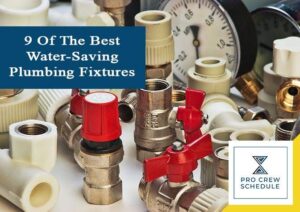Despite the fact that the Earth is mostly made up of water, water shortage is a growing problem. A significant factor causing this problem is wasted water due to leaks, which wastes about 1.7 trillion gallons of water worldwide.
And one of the primary sources of wasted water that often gets overlooked is old plumbing fixtures. There are several fixtures that remain in a building for years. Even though they technically still function, they consume far more water compared to modern components. As a result, buildings pay more in water bills over time than upgrading several of their plumbing fixtures.
In the same way, contractors have a crew scheduler to help them manage their projects; plumbing systems have upgrade fixtures to help them perform efficiently.
Luckily, with modern technology and the growing concern of water scarcity, manufacturers are continually coming up with new designs and products that focus on water efficiency and conservation. If project management for construction opts for these kinds of fixtures from the get-go in the building process, the client will save a great deal of water and costs.
Water-Saving Plumbing Fixtures
1. Water-efficient faucets
Leaky faucets are a significant source of wasted water, so it makes sense that it is one of the best plumbing features to upgrade.
Performance faucets generally reduce the amount of water that flows through them with gaskets and aerators’ help. An aerator, a type of gasket, adds air to the water does it down while still maintaining pressure.
On average, water-efficient faucets cut water usage from about 2.2 gallons per minute to 1.5 gallons per minute. Some variants also have filters in the taps that make water clean enough for drinking.
2. High-efficiency toilets (HET)
About 40% of toilets in use are older models that flush about 3.5 gallons per flush. On the other hand, newer high-efficiency models lower that number to less than 1.3 gallons per flush. They are able to do this with velocity to help flush with less water. Design changes include incorporating air pressure in a power-flush toilet and gravity in a gravity-flow toilet to expel waste with minimal amounts of water.
The EPA says that the average homeowner can save as much as $100 a month in water bills if they use high-efficiency toilets. Also, they’ll be able to save thousands of gallons a year if they switch out their older models.
3. Dual flush toilets
Dual flush toilets are another variant that can help in conserving water. Toilets flush a lot of water away. But this type of toilet has two flush modes that use different amounts of water depending on what the toilet was used for.
Moreover, they don’t rely on water but also a more powerful flush to rid toilet waste that uses less water.
4. Low-flush toilets
Aside from high-efficiency and dual flush toilets, low-flush toilets are another option to reduce water usage. This popular choice is very water-efficient that the US and Canada have made it a standard that’s upheld by law.
When your clients make the switch, they’ll be consuming about 1.5 gallons per flush and will be able to save as much as 6 gallons per flush. Low-flush toilets have come a great way from their introduction in the 1990s.
5. Performance showerheads
A typical showerhead uses about 2.5 gallons of water per minute. But when it’s upgraded to a performance showerhead, it could reduce that to 1.75 gallons per minute.
Performance showerheads, not unlike water-efficient faucets, cut down the amount of water that flows through them while still maintaining the needed water pressure.
When a typical household makes the switch to performance showerheads, they could save as much as 2,900 gallons of water a year. Subsequently, that house will incur lower electric bills, in addition to saving water costs. The water heater’s usage also reduces as less hot water is used. Plus, even though the amount of water is reduced, it isn’t noticeable when taking a shower.
6. Pressure-reducing valves (PRV)
PRVs are set on the main water line to lower the pressure of water. This fixture is ideal for residential areas, where a typical home’s plumbing can perform just fine at just 35 psi. However, plenty of homes unknowingly use pressure at a higher level, resulting in wasted water.
As a professional plumber, add checking the water pressure on your maintenance checks. If you find that a home is using a higher PSI than needed, consider installing a PRV. You can then visualize a timeline for the project. This innovative plumbing fixture saves water and cuts down costs and extends the pipes’ lifespan.
7. Recirculating hot water systems
Recirculating hot water systems have already been in use in commercial buildings like hostels, but newer variants of this fixture are now available for residential settings.
Essentially, this kind of system recirculates old hot water and stores it in a tank. Then, it sends water from the tank to faucets and showers as needed. It lessens the amount of cold water wasted when waiting for it to heat up, as it heats the water faster.
An additional benefit of recirculating hot water systems is the ease of installation, and it can often qualify homeowners for tax breaks on a local and state level. Advise your customers with this system or are thinking about getting this system to check with their local officials to know what breaks installing recirculating hot water systems offer.
8. Tankless water heaters
Not many people know this, but water heaters are the second-highest energy usage source in a home. So, a wise option is to install tankless water heaters; it’s an excellent way for homeowners to cut down costs on powering the heating appliance and conserve energy.
Tankless water heaters (or on-demand water heaters) are 22% more efficient compared to the average gas-fired-storage water tanks. They are even powered by electricity, a much cleaner alternative. In terms of size and appearance, these water heaters are slim and compact, allowing it to fit in showers easily and lessens the time the user has to wait for hot water to be conducted.
9. Water heater timer
An alternative to a tankless water heater is a digital water heater timer. Similar to a thermostat or water sprinkler system, the heater will begin operation when the timer says it’s needed. This will save the homeowner a lot of energy, water, money, and even time.
Water-Saving Tips You Can Share With Your Customers
In addition to installing the water-saving plumbing fixtures mentioned above, people can do a few other things to reduce their water consumption. Here are a few tips you can share with your clients.
- Upgrade or replace faulty faucets
- Shorten the distance hot water travels
- Turn off the tap
- Make a water inventory
- Repair and eliminate leaks
- Check the faucets’ aerators
- Lower the pressure
- Seek professional plumbing advice
Importance and Benefits of Water Conservation
a. Lower water costs
This is possibly the most practical reason to think about water conservation.
Plumbing systems are complex and made up of filters, pumps, pipes, and drains that carry clean water and sanitarily take wastewater out. So, building, maintaining, and repairing these systems cost some money. To somewhat offload that cost, monthly utility bills and taxes are put into place.
As a house uses water, the provider– though a water meter– monitors the usage by the gallon. They measure precisely how much is being used.
b. Save energy
Electricity is needed to transport, move and process, and recycle water. This process consumes up to 20% of the state’s electricity use. In a nutshell, reducing the amount of water used subsequently decreases the amount of electricity needed, doubling the benefit of being eco-friendly and cutting down utility bills.
c. Solve global water shortage
We mentioned in the beginning how water shortage is a growing problem on the planet. This is because the supply of fresh water remains constant while the demand increases due to population and industry growth. And even though the water cycle replenishes the Earth’s water supply, the location, quality, and quantity constantly vary. Also, despite the fact that the Earth is majorly made up of water, only 1% of it is potable or safe to drink.
With that said, reducing the amount of water used and preventing water from being wasted can protect the world against water shortage and future droughts.
d. Prevent subsequent economic and political consequences
As an effect of an inadequate water supply, the political and economic landscape shifts. Prices rising, food supplies dwindling, political conflict, and health hazards are just some of the consequences that may happen.
e. Protect the environment
Ultimately, water conservation protects the environment. Circling back to reason number two, reducing water usage consumes less energy needed to deliver and process it. Also, water is vital to practically everything– humans, plants, and animals. With a healthy supply of clean water, all these life forces can be sustained.
Are you a plumbing contractor looking for effective subcontractor scheduling software? Use Pro Crew Schedule to help you with your project’s task management. Sign up today and get a free 30-day trial with all its features.







